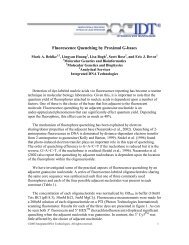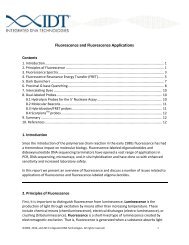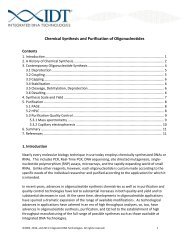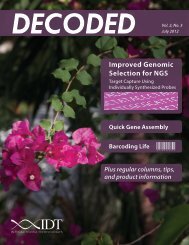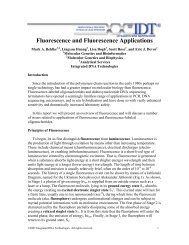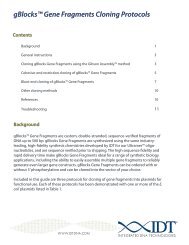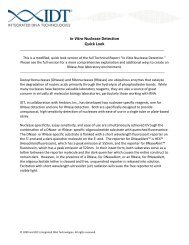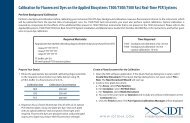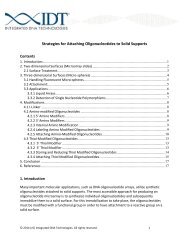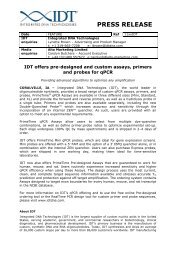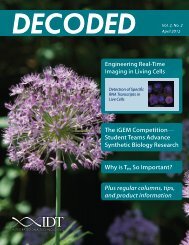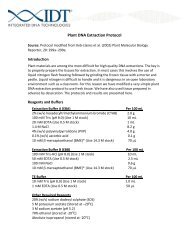Improved Print and QC Methods for Oligonucleotide Arrays
Improved Print and QC Methods for Oligonucleotide Arrays
Improved Print and QC Methods for Oligonucleotide Arrays
You also want an ePaper? Increase the reach of your titles
YUMPU automatically turns print PDFs into web optimized ePapers that Google loves.
Image Analysis <strong>and</strong> QuantificationAnalysis of the oligo-array scans was per<strong>for</strong>med using OptiQuant (Perkin Elmer). The analysisgrid was set so that each cell was of equal size <strong>and</strong> larger than the probe spots. Background was definedby setting an extra analysis-cell column of equal size <strong>and</strong> replicate number to the probe analysis-cellcolumns <strong>and</strong> adjacent to the array in an area contained within the cover slip hybridization area that wasneither printed on nor touched by the printer pins. For each array, the average analysis-cell backgroundwas subtracted from each probe analysis-cell <strong>and</strong> the result was normalized to the area of the probe spot,which was based on the average diameter of the replicates <strong>for</strong> each probe. The replicate values were thencombined to calculate an average DLU/mm2 <strong>and</strong> st<strong>and</strong>ard deviation <strong>for</strong> each probe. The relative percentsignals were then graphed <strong>for</strong> comparisons.Table 4:Comparison of Commercially Available Nonamers <strong>for</strong> Array <strong>QC</strong>.Scanner (Ex/Em)Name Vendor Dye Wave Lenghts Hyb Conditions Wash ConditionsHybChecker Sigma Atto 655 633/670 [?µM] 1X SSC/0.03% SDS <strong>for</strong> 2 minssupplied buffer0.2X SSC <strong>for</strong> 2 mins0.05X SSC <strong>for</strong> 2 minsSpotCheck Genetix Cy3 543/570 [10µM] 2X SSC/0.2% SDS <strong>for</strong> 2 minssupplied buffer2X SSC <strong>for</strong> 2 mins0.5X SSC <strong>for</strong> 20 secsAlexa-546 * Molecular Alexa-546 543/570 [7.5µM] 2X SSC/0.2% SDS <strong>for</strong> 2 minsPanomer Probes 4X SSC 2X SSC <strong>for</strong> 2 mins1mg/ml poly(dA)0.5X SSC <strong>for</strong> 20 secs50mM HEPES pH70.2% SDSSeeIt† TeleChem Cy3 543/570 [10µM] 2X SSC/0.1% sarkosyl <strong>for</strong> 1.5 minsSuperHyb2X SSC <strong>for</strong> 1 mins0.5X SSC <strong>for</strong> 10 secsCy3-Nonamer IDT Cy3 543/570 [2µM] 10X SSC/0.2% sarkosyl <strong>for</strong> 4-5 minssupplied buffer10X SSC <strong>for</strong> 2 mins2X SSC <strong>for</strong> 20 secs* recommended hyb buffer not available from supplier† recommended hyb buffer available; sold separatelyRESULTS AND DISCUSSIONOptimization of Attachment Chemistry & <strong>Print</strong> BufferMicroarrays were printed using 70mer oligonucleotide probes with unmodified, amino-mod, <strong>and</strong>hydrazide-mod 5’-ends on various slide surfaces <strong>and</strong> were hybridized to complementary Cy5-labeledoligo targets. Large variations in signal intensities were observed. Between the different slide surfacechemistries examined, relative signal intensity varied as follows (Figure 1):Amine Surface > Aldehyde Surface >> Epoxy SurfaceNote that the same print conditions, oligo concentrations, hybridization conditions, <strong>and</strong> scanner lasersettings were employed. The epoxy surface had the lowest overall probe-binding capacity of the threesurfaces. <strong>Print</strong> buffer composition also significantly affected final spot morphology <strong>and</strong> image intensity.In general, the addition of betaine to the print buffer improved the sensitivity <strong>and</strong> uni<strong>for</strong>mity of thehybridized array spots on both aldehyde <strong>and</strong> amine surfaces (the sole exception being the sodiumhydroxide buffer where the addition of betaine appears to decrease probe attachment). In the absence ofcovalent-coupling with UV or heat treatment, use of betaine increased relative probe attachment (in rankorder):Hydrazide Modified > Amine Modified > Unmodified oligosThe beneficial effect of betaine was greater on the amine surface than on the aldehyde surface.Unexpectedly, the hydrazide-modification showed best attachment to the amine surface, even though we



